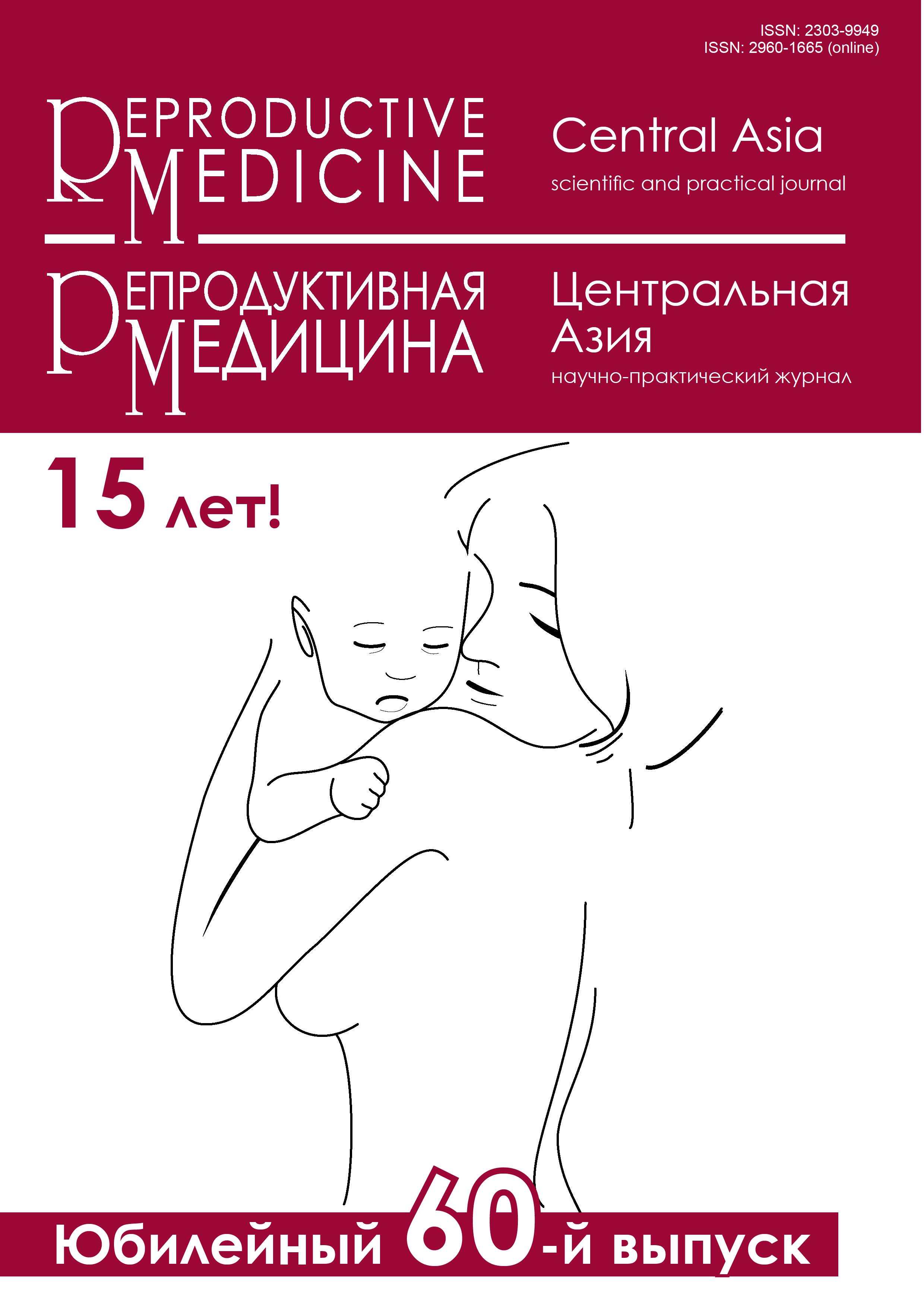Abdominal delivery after IVF: Justifications and risks
DOI:
https://doi.org/10.37800/RM.3.2024.73-81Keywords:
infertility, pregnancy, in vitro fertilization (IVF), cesarean section (C-section), abdominal deliveryAbstract
Relevance: Pregnancy following in vitro fertilization (IVF) is often considered high-risk, leading to an increased preference for cesarean sections (C-sections), even without strict medical indications. With the global rise in IVF pregnancies, the choice of delivery method has become increasingly critical.
The study aimed to study the causes of abdominal deliveries after IVF and the assessment of the justification for such decisions from the perspective of medical necessity.
Materials and Methods: A retrospective analysis was conducted on 1,592 women who underwent IVF through a program funded by the Health Insurance Fund of Kazakhstan. The study focused on clinical pregnancy outcomes, particularly the rate of C-sections among full-term pregnancies, across different healthcare organizations. The IVF procedures were performed at the Ecomed Сlinic from 2020 to 2022, with data analysis including comparisons of cesarean and natural birth rates and maternal and child outcomes.
Results: From 2020 to 2022, the clinical pregnancy rate after IVF, according to the data of the «Ecomed» clinic, was 46%, which shows the program’s effectiveness. However, the C-section rate was high and increased to 69% in 2022, significantly above the recommended range by WHO.
Conclusion: The high C-section rate following IVF, according to the results of this study, highlights the need to reassess management strategies for these pregnancies. Developing national guidelines based on strict medical criteria and addressing regional variations could improve delivery practices and reduce unnecessary surgeries.
References
Vissers J, Sluckin TC, Van Driel-Delprat CCR, Schats R, Groot CJM, Lambalk CB, Twisk JWR, Huirne JAF. Reduced pregnancy and live birth rates after in vitro fertilization in women with previous Caesarean section: a retrospective cohort study. Human Reproduction. 2020;35(3):595-604.
https://doi.org/10.1093/humrep/dez295
Riemma G, De Franciscis P, Torella M, Narciso G, La Verde M, Morlando M, Cobellis L, Colacurci N. Reproductive and pregnancy outcomes following embryo transfer in women with previous cesarean section: A systematic review and meta-analysis. Acta obstetricia et gynecologica Scandinavica. 2021;100(11):1949-1960.
https://doi.org/10.1111/aogs.14239
Kamath MS, Kirubakaran R, Mascarenhas M, Sunkara SK. Perinatal outcomes after stimulated versus natural cycle IVF: a systematic review and meta-analysis. Reproductive biomedicine online. 2018;36(1):94-101.
https://doi.org/10.1016/j.rbmo.2017.09.009
Исенова СШ, Тлеукул НА, Арипханова АС, Боран АМ, Макулбекова НО. Особенности течения и ведения беременности после применения экстракорпорального оплодотворения. Репродуктивная медицина. 2023;2(55):17-24.
Isenova SSh, Tleukul NA, Ariphanova AS, Boran AM, Makulbekova NO. Features of the course and management of pregnancy after the use of in vitro fertilization. Reproduktivnaja medicina. 2023;2(55):17-24. (In Russ.).
https://doi.org/10.37800/RM.2.2023.17-24
Wessel JA, Mol F, Danhof NA, Bensdorp AJ, Tjon-Kon Fat RI, Broekmans FJM, Hoek A, Mol BWJ, Mochtar MH, Van Wely M, INeS and SUPER Study Group. Birthweight and other perinatal outcomes of singletons conceived after assisted reproduction compared to natural conceived singletons in couples with unexplained subfertility: follow-up of two randomized clinical trials. Human reproduction. 2021;36(3):817-825.
https://doi.org/10.1093/humrep/deaa298
Betrán AP, Temmerman M, Kingdon C, Mohiddin A, Opiyo N, Torloni MR, Zhang J, Musana, O, Wanyonyi SZ, Gülmezoglu AM, Downe S. Interventions to reduce unnecessary caesarean sections in healthy women and babies. Lancet. 2018;392(10155):1358-1368.
https://doi.org/10.1016/S0140-6736(18)31927-5
Chen I, Opiyo N, Tavender E, Mortazhejri S, Rader T, Petkovic J, Yogasingam S, Taljaard M, Agarwal S, Laopaiboon M, Wasiak J, Khunpradit S, Lumbiganon P, Gruen RL, Betran AP. Non-clinical interventions for reducing unnecessary caesarean section. The Cochrane database of systematic reviews. 2018;9(9):CD005528.
https://doi.org/10.1002/14651858.CD005528.pub3
Lodge-Tulloch NA, Elias FTS, Pudwell J, Gaudet L, Walker M, Smith GN, Velez MP. Caesarean section in pregnancies conceived by assisted reproductive technology: a systematic review and meta-analysis. BMC pregnancy and childbirth. 2021;21(1):244.
https://doi.org/10.1186/s12884-021-03711-x
Pettersson ML, Nedstrand E, Bladh M, Svanberg AS, Lampic C, Sydsjö G. Mothers who have given birth at an advanced age - health status before and after childbirth. Scientific reports. 2020;10:9739.
https://doi.org/10.1038/s41598-020-66774-4
Zhao J, Hao J, Xu B, Wang Y, Li Y. Impact of previous Caesarean section on reproductive outcomes after assisted reproductive technology: systematic review and meta-analyses. Reproductive biomedicine online. 2021;43(2):197-204.
https://doi.org/10.1016/j.rbmo.2021.04.007
World Health Organization. WHO recommendations non-clinical interventions to reduce unnecessary caesarean sections. World Health Organization. – 2018.
https://www.who.int/publications/i/item/9789241550338
Рустамова ША, Кахрамонова АК. Последствия у детей, родившихся путем операции кесарево сечения (на примере Самаркандской области). Uzbek journal of case reports. 2023;3(3):90-92.
Rustamova ShA, Kahramonova AK. Consequences in children born by caesarean section (using the example of the Samarkand region). Uzbek journal of case reports. 2023;3(3):90-92. (In Russ.).
Hoang DM, Levy EI, Vandenplas Y. The impact of Caesarean section on the infant gut microbiome. Acta Paediatrica. 2021;110:60-67.
https://doi.org/10.1111/apa.15501
Тумаева ТС, Балыкова ЛА, Ледяйкина ЛВ, Науменко ЕИ, Самошкина ЕС, Гарина СВ, Целкович ЛС. Дети, извлеченные путем кесарева сечения: структурно-функциональные особенности сердца на первом году жизни. Вопросы практической педиатрии. 2018;6(13):7-15.
Tumaeva TS, Balykova LA, Ledjajkina LV, Naumenko EI, Samoshkina ES, Garina SV, Celkovich LS. Children delivered by cesarean section: structural and functional features of the heart in the first year of life. Voprosy prakticheskoj pediatrii. 2018;6(13):7-15. (in Russ.).
https://www.elibrary.ru/item.asp?id=36946777
Грищенко О.В., Мамедова С.Ш. Прогнозирование слабости родовой деятельности, ставшей причиной кесарева сечения. Репродуктивная медицина. 2020;2(43):56-59.
Grishhenko OV, Mamedova SSh. Prediction of labor weakness leading to cesarean section. Reproduktivnaja medicina. 2020;2(43):56-59. (In Russ.).
https://doi.org/10.37800/RM2020-1-14
Сармулдаева Ш.К., Локшин В.Н. Современные принципы ведения беременности и родов после вспомогательных репродуктивных технологий. Репродуктивная медицина. 2019;1(38):37-43.
Sarmuldaeva ShK, Lokshin VN. Modern principles of pregnancy and childbirth management after assisted reproductive technologies. Reproduktivnaja medicina. 2019;1(38):37-43. (in Russ.).
https://repromed.kz/index.php/journal/article/view/87
Pokulniewicz M, Januszewski M, Pluta K, Jakimiuk A, Oleksik T, Zytynska-Daniluk J, Santor-Zaczynska M, Jakimiuk A. Assessment of the birth status of children born by elective caesarean section before and after 39 weeks of gestation following in vitro fertilization. Ginekologia Polska. 2023;94(11):922-928.
https://doi.org/10.5603/GP.a2022.0137
Issanov A, Aimagambetova G, Terzic S, Bapayeva G, Ukybassova T, Baikoshkarova S, Utepova G, Daribay Z, Bekbossinova G, Balykov A, Aldiyarova A. Impact of governmental support to the IVF clinical pregnancy rates: Differences between public and private clinical settings in Kazakhstan—A prospective cohort study. BMJ open. 2022;12(2):e049388.
https://doi.org/10.1136/bmjopen-2021-049388
Алтаева А.А., Исенова С.Ш., Эгле М. Внедрение классификации Робсон в Республике Казахстан для снижения частоты кесарева сечения. Вестник КазНМУ. 2019;3:18-24.
Altaeva AA, Isenova SSh, Jegle M. Implementation of the Robson classification in the Republic of Kazakhstan to reduce the incidence of cesarean section. Vestnik KazNMU. 2019;3:18-24. (In Russ.).
Алтаева А.А., Исенова С.Ш., Эгле М., Бодыков Г.Ж. Определение абсолютного и относительного вклада показаний к операции кесарева сечения в соответствии с классификацией Робсона в родовспомогательном учреждении III уровня города Алматы. Вестник КазНМУ. 2020;2:28-31.
Altaeva AA, Isenova SSh, Jegle M, Bodykov GZh. Determination of the absolute and relative contribution of indications for cesarean section in accordance with the Robson classification in a level III obstetric institution in Almaty. Vestnik KazNMU. 2020;2:28-31. (In Russ.).
Downloads
Published
How to Cite
Issue
Section
License
Copyright (c) 2024 The rights to a manuscript accepted for publication are transferred to the Journal Publisher. When reprinting all or part of the material, the author must refer to the primary publication in this journal.

This work is licensed under a Creative Commons Attribution-NonCommercial-NoDerivatives 4.0 International License.
The articles published in this Journal are licensed under the CC BY-NC-ND 4.0 (Creative Commons Attribution – Non-Commercial – No Derivatives 4.0 International) license, which provides for their non-commercial use only. Under this license, users have the right to copy and distribute the material in copyright but are not permitted to modify or use it for commercial purposes. Full details on the licensing are available at https://creativecommons.org/licenses/by-nc-nd/4.0/.




